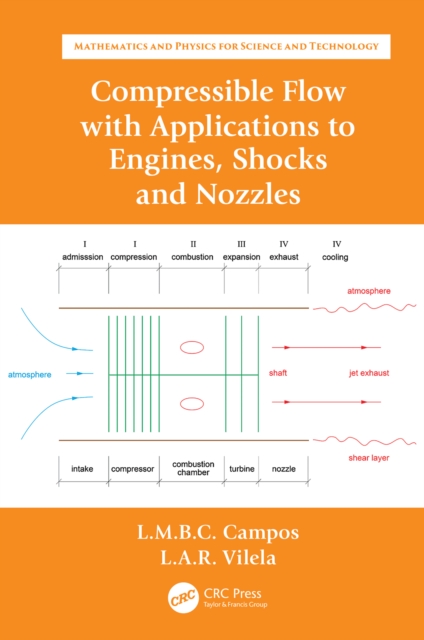
Compressible Flow with Applications to Engines, Shocks and Nozzles PDF
by Luis Manuel (University of Lisbon, Portugal) Braga da Costa Campos, Luis Antonio Raio Vilela
Part of the Mathematics and Physics for Science and Technology series
Description
Compressible Flow with Application to Shocks and Propulsion is part of the series "Mathematics and Physics for Science and Technology", which combines rigorous mathematics with general physical principles to model practical engineering systems with a detailed derivation and interpretation of results.
Volume V presents the mathematical theory of partial differential equations and methods of solution satisfying initial and boundary conditions, and includes applications to: acoustic, elastic, water, electromagnetic and other waves; the diffusion of heat, mass and electricity; and their interactions.
This is the second book of the volume. The first book of volume V starts with the classification of partial differential equations and proceeds with similarity methods that apply in general to linear equations with constant coefficients and all derivatives of the same order, such as the Laplace and Biharmonic equations, without and with forcing.
The similarity solutions are also applied to Burger's non-linear diffusion equation.
First-order linear and quasi-linear partial differential equations with variable coefficients are considered, with application to the representation of conservative/non-conservative, solenoidal/rotational and Beltrami/helical vector fields by one, two or three scalar and/or one vector potential in relation with exact, inexact and non-integrable differentials.
The latter appear in the first and second principles of thermodynamics that specify the constitutive and diffusive properties of matter as concerns thermal, mechanical, elastic, flow, electrical, magnetic and chemical phenomena and their interactions.
The book is intended for graduate students and engineers working with mathematical models and can be applied to problems in mechanical, aerospace, electrical and other branches of engineering dealing with advanced technology, and also in the physical sciences and applied mathematics. This book: Simultaneously covers rigorous mathematics, general physical principles and engineering applications with practical interest Provides interpretation of results with the help of illustrations Includes detailed proofs of all resultsL.M.B.C.
Campos was chair professor and the Coordinator of the Scientific Area of Applied and Aerospace Mechanics in the Department of Mechanical Engineering and also the director (and founder) of the Center for Aeronautical and Space Science and Technology until retirement in 2020. L.A.R. Vilela is currently completing an Integrated Master's degree in Aerospace Engineering at Institute Superior Tecnico (1ST) of Lisbon University.
Information
-
Download - Immediately Available
- Format:PDF
- Pages:294 pages, 27 Tables, black and white; 47 Line drawings, black and white; 47 Illustrations, black an
- Publisher:Taylor & Francis Ltd
- Publication Date:30/11/2022
- Category:
- ISBN:9781000415995
Information
-
Download - Immediately Available
- Format:PDF
- Pages:294 pages, 27 Tables, black and white; 47 Line drawings, black and white; 47 Illustrations, black an
- Publisher:Taylor & Francis Ltd
- Publication Date:30/11/2022
- Category:
- ISBN:9781000415995










